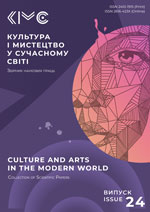Traditional Non-Human Identity in Historical and Cultural Dynamics
(Using the Example of Elven Identity)
DOI:
https://doi.org/10.31866/2410-1915.24.2023.287654Keywords:
transhumanism, posthuman anthropology, other, otherkin, non-human, other-than-human identities, elven identity, frontierAbstract
The aim of the article is to conceptualise the self-definition type of “traditional other-than-human identities: mythological creatures” based on the material of elven identity. The research methodology within cultural studies is based on the principles of posthuman anthropology and studies of non-human identities in foreign humanities. Results. The transformation of perceptions about elves is considered and an analysis of elven identity among homo sapiens in the diachrony of culture is carried out. The features of its existence in premodern, modern, post-, and metamodern contexts are determined. The essence and reasons for the popularity of elven identity are revealed. The article’s hypothesis is confirmed, suggesting that other-than-human identities among biological people manifest themselves throughout human history. A comprehensive solution to these issues constitutes the scientific novelty of the work. Conclusions. The conceptualisation of the notion of “traditional other-than-human identities: mythological creatures” in a wide diachronic dimension of cultural dynamics made it possible to take a holistic view of the phenomenon of non-human identity among people. The author of the article argues that non-human identities are often transgressive in nature and belong to cultural universals of humanity. Mythological identities are represented in traditional representations of archaic and premodern. In the era of modernity, non-human identities are somewhat marginalised within the culture. Post- and metamodern actualises premodern beliefs. Mythological non-human identities among people, along with traditional interpretations, acquire new interpretations. In particular, they begin to be interpreted as parts of an individual’s psyche or as a result of a transhumanist transition to an alternative transhuman ideal.
References
Cusack, C. M. (2017). Spirituality and self-realisation as "other-than-human": The Otherkin and Therianthropy communities. In C. M. Cusack, & P. Kosnáč (Eds.), Fiction, Invention and Hyper-reality: From popular culture to religion (pp. 40–57). Routledge. https://doi.org/10.4324/9781315582283 [in English].
Davidsen, M. A. (2014). The spiritual Tolkien milieu: A study of fiction-based religion [Doctoral Thesis, Leiden University] [in English].
Davidsen, M. A. (2017). The Elven Path and the Silver Ship of the Valar: Two spiritual groups based on J. R. R. Tolkien’s Legendarium. In C. M. Cusack, & P. Kosnáč (Eds.), Fiction, Invention and Hyper-reality: From popular culture to religion (pp. 15–30). Routledge. https://doi.org/10.4324/9781315582283-8 [in English].
Doel, F., & Doel, G. (2009). Folklore of Northumbria. The History Press [in English].
Elves in Paradise. (n.d.). The Silver Elves. http://silverelves.angelfire.com/ [in English].
Haraway, D. J. (1991). Simians, cyborgs, and women: The reinvention of nature. Routledge. https://doi.org/10.4324/9780203873106 [in English].
Hots, L. S. (2022). Transhumanizm u synkhronno-diakhronnomu vymiri kultury: Kontseptualizatsiia, typolohiia i periodyzatsiia [Transhumanism in synchrony and diachrony of culture: Conceptions, typology and periods]. Issues in Cultural Studies, 39, 10–20. https://doi.org/10.31866/2410-1311.39.2022.256888 [in Ukrainian].
Killings, D. B. (Ed.). (1995). The Life and Death of Cormac the Skald ("Kormak’s Saga") (W. G. Collingwood & J. Stefansson, Trans.). Medieval Celtic Library. http://mcllibrary.org/Cormac/ [in English].
Rolleston, T. W. (1910). The High Deeds of Finn and other Bardic Romances of Ancient Ireland (S. Reid, Ill.). G. G. Harrap & Co. https://www.luminarium.org/mythology/ireland/oisinyouth.htm [in English].
Sadeleer, A. S. de (2016). Articulating Non-Humanity: Discourse Analysis to Discover the Otherkin Community. University of Groningen [in English].
Shea, S. C. (2019). Identity and Belief: An Analysis of the Otherkin Subculture [Master Thesis, University of Amsterdam] [in English].
Silver Elves. (2017, July 1). Is Being an Elf a Matter of Blood of Genetic Heritage? The Silver Elves Blog. https://silverelves.wordpress.com/2017/07/01/is-being-an-elf-a-matter-of-blood-of-genetic-heritage/ [in English].
Tigges, W. (2015). Tochmarc Étaíne: An Old Irish Narrative. Wim Tigges.
Downloads
Published
How to Cite
Issue
Section
License

This work is licensed under a Creative Commons Attribution 4.0 International License.
Authors who publish in this journal agree to the following terms:
1) The authors reserve the right to the authorship of their work and transfer to the journal the right to first publish this work under the terms of the Creative Commons Attribution License, which allows others to freely distribute the published work with a mandatory reference to the authors of the original work and the first publication of the work in this journal.
2) The authors have the right to enter into independent additional agreements for non-exclusive distribution of the work in the form in which it was published by this journal (for example, to place the work in the electronic repository of the institution or to publish it as part of a monograph), provided that the reference to the first publication of the work in this journal is maintained.
3) The journal's policy allows and encourages authors to post their manuscripts on the Internet (for example, in institutional repositories or on personal websites) both before submitting the manuscript to the editorial board and during its editorial processing, as this contributes to the emergence of a productive scientific discussion and has a positive effect on the efficiency and dynamics of citation of published work (see The Effect of Open Access).






